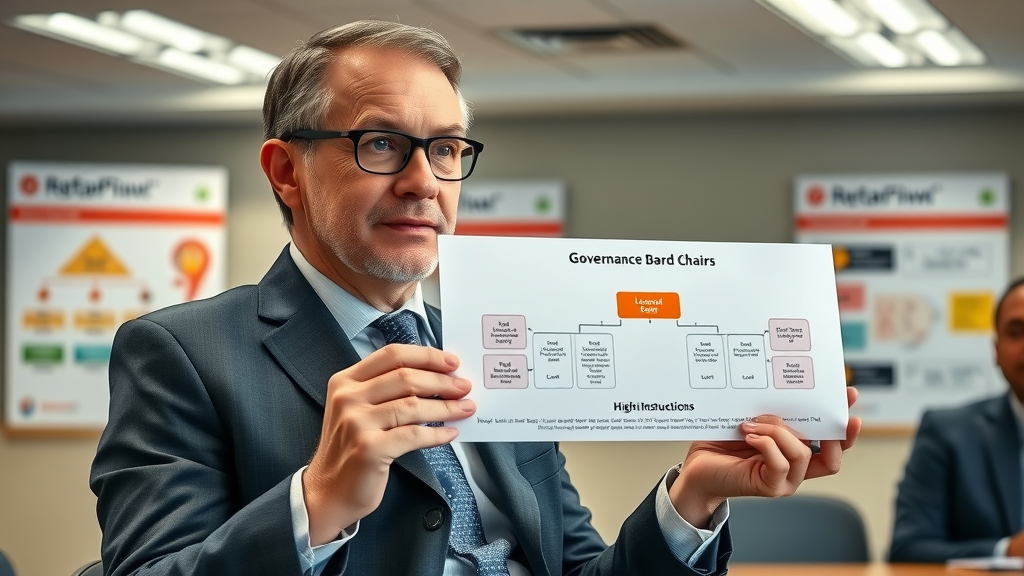Are you certain your nonprofit's board governance and leadership are fueling real impact, or just checking boxes? Explore how empowering boards go beyond compliance to ignite genuine organizational excellence and ensure sustainable success.
What You'll Learn About Board Governance and Leadership for Nonprofits
- Understand the foundations of board governance and leadership for nonprofits
- Differentiate between non-profit board and profit board structures
- Explore various governance models used by nonprofit boards
- Learn tips for board member recruitment and effective board meetings
- Review best practices for good governance and sustainable board leadership
- Access actionable strategies for nonprofit board management
Opening Hook: Challenging the Status Quo in Board Governance and Leadership for Nonprofits
"Is your nonprofit’s board governance and leadership truly driving impact, or merely fulfilling obligations? Discover how high-performing boards go beyond compliance to foster organizational excellence."
Understanding Board Governance and Leadership for Nonprofits
What is Board Governance?
Board governance is the system and framework an organization uses to make decisions, hold itself accountable, and pursue its mission. In the context of nonprofit board governance, this means the board of directors serves as the central governing body, responsible for ensuring the nonprofit achieves its goals ethically and efficiently. Board governance goes beyond mere oversight: it involves setting direction, shaping policy, and providing leadership that reflects the values and needs of the nonprofit sector. Unlike profit board structures that mainly focus on shareholder outcomes, nonprofit board governance prioritizes community benefit, good governance, and sustainable impact.
Effective leadership and governance help ensure that an organization's mission isn't lost amid challenges, regulatory requirements, or changing board composition. The board works closely with the executive director and staff to develop governance models that fit the unique needs of the organization and provide a structure for collective decision-making, risk management, and transparency. Whether you're part of a large council of nonprofits or a new nonprofit organization, understanding strong board governance models lays the groundwork for long-term success.

Key Elements of Board Leadership in Nonprofits
Board leadership in nonprofits means more than holding occasional board meetings. Strong leaders clarify the board’s vision, maintain the integrity of the nonprofit's values, and motivate other board members toward their shared mission. Key elements include clear role definitions, effective communication, a commitment to accountability, and fostering a collaborative culture. The board chair plays a pivotal leadership role, guiding discussions, resolving conflicts, and ensuring the board stays mission-focused. Successful boards leverage the diverse skills and passions of their members while holding themselves to high standards of good governance and ethical decision-making.
By cultivating a climate of trust, respect, and clarity, effective board leadership helps align everyone’s efforts toward mission objectives. Both returning and new nonprofit board members benefit from leadership that encourages ongoing education, self-assessment, and adaptation. These traits not only enhance individual board member performance but also uplift the governing body as a whole, resulting in boards that are responsive, impactful, and highly trusted by staff and stakeholders.
Good Governance: Principles and Importance
Good governance is essential for any nonprofit organization aspiring toward long-term impact and credibility. It embodies principles such as transparency, accountability, integrity, and inclusivity. Adopting good governance practices helps nonprofit boards avoid common pitfalls such as mission drift, conflicts of interest, or lapses in compliance. Robust governance models empower the board of directors to make informed decisions, manage risks, and ensure that the nonprofit fulfills both its legal duties and its obligations to beneficiaries and donors.
For nonprofit boards, prioritizing good governance builds public trust and stakeholder confidence. It allows organizations to weather challenges—including changes in leadership and board composition—without losing sight of their purpose. Many successful nonprofit organizations treat governance guidelines as living documents, regularly updated to reflect best practice and evolving circumstances. By keeping governance practices front and center, nonprofits maximize their mission impact.
Nonprofit Board vs. Profit Board: Governance Models Compared
| Aspect | Nonprofit Board | Profit Board |
|---|---|---|
| Purpose | Mission-driven; public/community benefit | Shareholder value and profit maximization |
| Governance Models | Policy, Advisory, Working, and Hybrid | Corporate, Advisory, and Management Models |
| Fiduciary Obligations | Legal, ethical, and stewardship duties | Legal and corporate compliance |
| Board Composition | Volunteers, community leaders, stakeholders | Shareholders, executives, outside experts |
| Leadership Structure | Board chair, committees, executive director | Board chair, CEO, standing committees |
| Decision-Making | Consensus-building, collaborative focus | Market-driven, top-down structure |
Unique Aspects of Nonprofit Board Governance
Nonprofit board governance is distinguished by its focus on mission fulfillment rather than financial return. Boards are made up of individuals driven by passion for the organization's cause, not compensation. This intrinsic motivation often results in more collaborative, inclusive governance practices and requires careful attention to board composition and diversity. Unlike a profit board of directors that centralizes authority with shareholders, nonprofit boards are accountable to donors, the public, and regulators.
This unique structure means nonprofit board members must balance strategic oversight with resources, regulatory compliance, and a commitment to ethical values. Because there’s no ownership stake, the board’s efforts are invested in public trust and the measurable impact of the nonprofit organization's work. It's also common for nonprofit governance models to integrate stakeholder representation in a way that’s rare in for-profit boards, further reinforcing transparency and service to mission.

Governance Model: Selection and Alignment with Mission
Choosing the right governance model is essential for nonprofit board effectiveness. Whether you select a policy, working, advisory, or hybrid model, the choice should align closely with the organization's mission, size, and operational realities. For example, a policy governance model clarifies board and staff roles through precise delegation and monitoring, ideal for larger organizations or councils of nonprofits. A working or advisory model may be practical for new or small nonprofits with fewer resources.
Whatever the governance framework, it must allow the board to make decisions efficiently, support fiduciary duties, and avoid blurring boundaries between governance and management. Boards must periodically review and adapt their chosen model as the nonprofit grows—ensuring it always supports good governance, robust oversight, and sustained mission achievement.
Board of Directors: Roles and Responsibilities in Board Governance and Leadership for Nonprofits
- Strategic direction and oversight
- Fiduciary duties
- Policy formulation and compliance
- Executive leadership support
- Board meeting management
The board of directors is the governing body responsible for setting the nonprofit’s strategic direction and ensuring the mission is effectively pursued. Their collective responsibilities include establishing organizational policies, providing fiscal oversight, and monitoring program effectiveness. Each board member also bears fiduciary obligations—acting in the best interest of the organization, ensuring all activities maintain legal and ethical standards, and managing the nonprofit’s resources wisely.
In many well-run nonprofit boards, the board chair plays a critical leadership role, not only steering productive board meetings but also serving as a bridge between the board and staff such as the executive director. The board’s ability to work cohesively as a team ensures sound board management, strong nonprofit governance, and optimal board performance. Regular self-assessment and clear accountability structures help the board maintain transparency, address conflicts of interest, and continually strengthen overall board governance and leadership for nonprofits.
Board Composition and Board Member Recruitment for Nonprofit Boards
Crafting an Effective Board Governance Model
The foundation of strong board governance and leadership for nonprofits begins with crafting a governance model that reflects your organization’s goals, size, and community needs. Establishing a clear model—whether policy, advisory, working, or hybrid—ensures that everyone understands their responsibilities and lines of authority. This clarity is vital for guiding board member recruitment, meeting management, and ongoing board performance.
An effective governance model also articulates how the board interacts with the executive team, what types of committees are necessary, and how the board evaluates its own work. Key elements like board composition, diversity, and term limits should all align with the chosen governance framework, preventing conflicts of interest and fostering a culture of continuous improvement and adaptation for good governance.

Selecting and Onboarding Nonprofit Board Members
Recruiting and onboarding new nonprofit board members is a strategic process that directly impacts nonprofit governance and ultimate organizational success. Effective boards pursue potential board members intentionally, identifying gaps in board composition such as needed expertise or community representation. The recruitment process should be transparent, inclusive, and mission-oriented—often involving structured interviews, reference checks, and a clear articulation of board member expectations.
Onboarding is just as critical as selection. A robust orientation process ensures board members understand the nonprofit’s mission, governance model, legal obligations, and policies such as the conflict of interest policy. Ongoing education and mentorship from experienced board members increase new board member engagement and help align everyone with best practices in board governance and leadership for nonprofits.
Board Diversity and Inclusion Best Practices
Modern nonprofit governance increasingly recognizes the vital role of board diversity and inclusion in board performance and effectiveness. Diverse boards foster creative problem-solving, offer broader perspectives, and reflect the composition of the communities they serve. Best practices involve intentional recruitment from various backgrounds—age, ethnicity, gender, experience level—and welcoming varied viewpoints into board decision-making.
To create a more inclusive governing body, organizations can implement mentoring programs, evaluate board composition annually, and structure board meetings to ensure every member’s voice is heard. A culture that prioritizes inclusion benefits not only the board of directors but also the nonprofit organization’s work as a whole, helping strengthen stakeholder trust and improve mission-aligned results.
Nonprofit Board Leadership: Best Practices for Effective Board Meetings
"Effective board leadership starts with intentional agenda-setting and open communication."
Planning Productive Board Meetings
The backbone of board governance and leadership for nonprofits lies in productive board meetings. Advance preparation, clear agendas, and a focus on outcomes help ensure meetings are not just formalities but catalysts for progress. Nonprofit boards benefit from setting expectations, sharing important materials prior to meetings, and allotting adequate time for discussion and decision-making.
Good governance practices recommend using standardized agendas that balance strategic planning, program oversight, financial review, and board member development. Regular evaluation of board meeting effectiveness—via post-meeting surveys or self-assessment—ensures ongoing improvement and maximizes time spent in service of the mission. Focusing on inclusivity during meetings also supports engagement from all board members and helps surface new ideas.
Board Chair: Leadership Traits and Facilitation Skills
An effective board chair is the linchpin of productive board meetings and overall nonprofit board leadership. To excel, the chair should demonstrate strong facilitation skills, clear communication, and integrity. Successful chairs are skilled at building consensus, mediating disagreements, and ensuring discussions stay focused on mission priorities rather than individual interests.
Traits such as emotional intelligence, impartiality, preparedness, and adaptability support a high-performing board and inspire board member engagement. The best board chairs not only lead by example during meetings but also empower others, encouraging professional development and ongoing board performance improvements. By maintaining high standards for leadership and governance, the chair ensures the board fulfills its strategic and fiduciary duties.

Nonprofit Board Member Engagement
High levels of board member engagement are a hallmark of effective nonprofit organizations. Engaged board members prepare for meetings, participate in committees, volunteer at events, and advocate for the organization in the community. Engagement doesn’t happen by accident—it results from clear expectations, meaningful involvement, and recognition of board member contributions.
Nonprofits can encourage engagement through mentorship programs, professional development opportunities, and periodic board self-assessments. Boards should also provide avenues for feedback and adapt volunteer roles to fit members’ skills and interests. Sustained board member engagement enhances nonprofit governance and drives stronger mission outcomes.
Governance Practices for a High-Performing Nonprofit Board
- Annual board self-assessments
- Establishing board committees
- Transparent board management reporting
- Continuous improvement and board development
- Alignment with governance models and mission
High-performing boards are distinguished by their adoption of best governance practices, from periodic board self-assessments to the strategic use of committees. Regular self-evaluation enables the board of directors to identify strengths and areas for improvement, ensuring ongoing board management and development. Committees enable boards to focus efforts in areas such as audit, finance, or governance, delegating tasks while keeping the full board engaged in oversight.
Transparent reporting builds trust with stakeholders and supports good governance, as do board training opportunities and external benchmarking. Most importantly, high-performing boards continuously align their governance models, leadership processes, and management approaches with the nonprofit’s evolving mission and needs—creating a lasting foundation for sustainability and growth.
Common Challenges in Board Governance and Leadership for Nonprofits
- Poor board member engagement
- Inefficient board meetings
- Lack of clarity in board governance models
- Difficulty in recruiting qualified board members
- Inadequate board management systems
Like any organization, nonprofits face challenges in board governance and leadership. One common hurdle is low board member engagement, which can undermine board performance and mission impact. Inefficient board meetings—dominated by routine updates rather than strategic decisions—can demotivate members and drain limited resources. Many nonprofits also struggle with unclear governance models, resulting in overlapping duties, confusion between the roles of board and staff, and increased risk of conflict of interest.
Recruiting and retaining qualified board members is an ongoing challenge, particularly for organizations unable to offer financial compensation. Finally, nonprofits with inadequate board management systems often lack the data and documentation necessary for accountability and transparent decision-making. Addressing these challenges requires dedication to good governance, leadership training, and ongoing evaluation.
Case Studies: How Strong Board Governance Inspires Nonprofit Success
Case Study 1: Transforming a Nonprofit Board Through Effective Governance
A mid-sized health nonprofit faced stagnant fundraising and poor stakeholder engagement due to unclear governance structures and low board member morale. By implementing a new board governance model focused on clear role delineation, robust onboarding, and scheduled board self-assessments, the organization saw remarkable improvement. Within a year, board meetings became more productive, committees worked more strategically, and donor trust rebounded with transparent board management reporting. The result: increased funding, innovative partnerships, and a measurable boost in overall board performance that has ensured long-term mission impact.
Their journey highlights that even the most challenged boards can evolve into high-performing governing bodies with deliberate investment in governance models and leadership development. Best of all, the improved board governance and leadership for nonprofits also inspired greater staff engagement and community trust.

Case Study 2: Improving Board Leadership for Organizational Growth
A growing environmental nonprofit realized its impact was limited by inconsistent board chair leadership and an overworked executive director. The board invested in leadership training and adopted a hybrid governance model, which clarified decision-making channels and enhanced collaboration between the board of directors and staff.
As a result, meetings became more focused, the board developed specialized committees to share the workload, and the nonprofit attracted new board members with diverse skill sets. This proactive approach to board governance and leadership for nonprofits unlocked new funding streams, strengthened partnerships, and multiplied the organization’s capacity to deliver on its mission.
People Also Ask: Board Governance and Leadership for Nonprofits
What is the difference between board governance and board management?
Board governance is the strategic oversight provided by the board of directors—setting mission, policy, and direction—while board management refers to the day-to-day administration implemented by staff and executive directors. Good governance models clarify these boundaries, ensuring the board remains focused on big-picture strategy and accountability, while management handles operations, resource allocation, and program delivery. Separating governance and management responsibilities leads to more effective nonprofits by preventing role confusion and supporting mission alignment.
What are the main models of nonprofit board governance?
Common governance models for nonprofit boards include the policy governance model (also known as Carver model), working board model, advisory board model, and hybrid models blending elements of the others. The policy governance model focuses the board on strategy and oversight, while a working board combines governance with hands-on operational tasks, frequent in smaller nonprofits. Each model offers distinct advantages; the choice depends on board composition, organizational size, and mission needs.
Why is board composition critical for nonprofit success?
Board composition ensures the board of directors includes the right mix of skills, backgrounds, and experiences to steer the nonprofit organization effectively. Diverse boards are better suited to address challenges, make decisions, and represent stakeholder communities. A balanced board composition fosters creative solutions, enhances nonprofit governance, and is essential for both good governance and sustainable nonprofit success.

How can nonprofits recruit and retain effective board members?
Successful recruitment combines targeted outreach, transparent expectations, and a mission-centric onboarding process. Nonprofits retain effective board members through recognition, meaningful engagement, relevant training, and opportunities for leadership roles. Regular feedback, a healthy organizational culture, and alignment with the nonprofit's goals help ensure ongoing board member motivation and retention.
What are common pitfalls in nonprofit board leadership and how can they be avoided?
Common pitfalls include lack of clear role definitions, insufficient meeting preparation, low board member engagement, neglect of compliance requirements, and poor conflict management. These can be avoided through strong board chair leadership, well-defined board governance models, regular self-assessment, and ongoing development opportunities for all board members.
How frequently should nonprofit boards meet to ensure good governance?
Effective nonprofits typically hold board meetings at least quarterly, though frequency can vary based on organizational needs. More frequent meetings (monthly or bimonthly) may benefit new or rapidly growing organizations. Consistent meetings with clear agendas, open communication, and focused discussions are essential for maintaining good governance and board performance.
FAQs about Board Governance and Leadership for Nonprofits
-
How does board governance affect nonprofit sustainability?
Robust governance models empower the board to set strategy, manage risk, and ensure resource stewardship, directly supporting long-term sustainability. -
Are there legal requirements for nonprofit board leadership?
Yes—nonprofit boards must comply with state and federal laws, maintain a governing body, follow bylaws, and often report conflicts of interest or financial disclosures. -
What should a nonprofit board meeting agenda include?
Effective agendas cover strategic review, program updates, financial oversight, compliance checks, and space for board member input or development. -
How do governance practices differ between small and large nonprofits?
Small nonprofits may blend board governance with operational duties, while larger organizations typically separate governance and management with more formal structures and committees. -
What training and resources exist for nonprofit board members?
Resources include local nonprofit alliances, the Council of Nonprofits, online courses, peer mentoring, and governance literature from sector leaders.
Key Takeaways: Board Governance and Leadership for Nonprofits
- Board governance and leadership for nonprofits are foundational to mission success.
- Effective governance models provide structure and accountability for nonprofit boards.
- Best practices in board leadership drive stakeholder trust and organizational growth.
- Ongoing board member development supports sustainable good governance.
Conclusion: Elevate Your Mission with Effective Board Governance and Leadership for Nonprofits
"The key to nonprofit success is not just good intentions, but exceptional board governance and leadership."
With the right governance models and engaged leadership, your nonprofit can maximize mission impact and ensure long-term resilience.
Ready to Strengthen Your Nonprofit's Board Governance and Leadership?
"Call me the Chaplain 786-333-5270"
To deepen your understanding of effective board governance and leadership in nonprofits, consider exploring the following resources:
- “Building Stronger Boards: Governance Best Practices for Nonprofits” (nonprofitsnapshot.org)
This article offers practical strategies to enhance board effectiveness, including fostering diversity and inclusion, engaging board members actively, and conducting regular self-assessments.
- “Boards That Lead: How Nonprofits Can Perform Better and Protect Their Future” (eidebailly.com)
This resource provides actionable steps for boards to lead with impact, such as clarifying roles, prioritizing financial literacy, and recruiting for diverse skills and perspectives.
By delving into these materials, you’ll gain valuable insights and practical tips to strengthen your nonprofit’s board governance and leadership, ultimately driving greater mission success.
 Add Row
Add Row  Add
Add 




Write A Comment